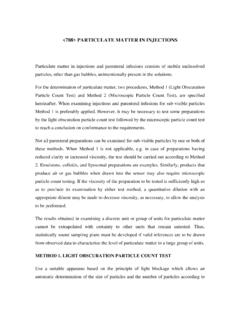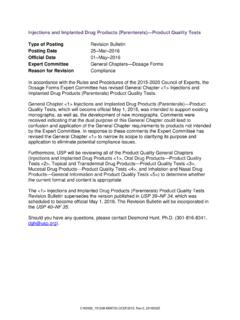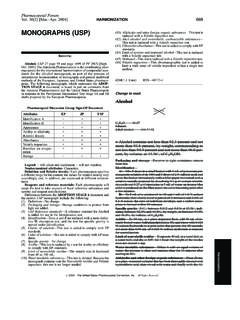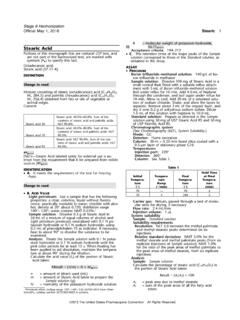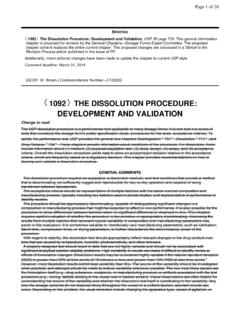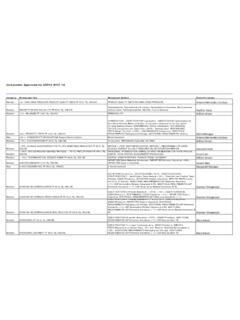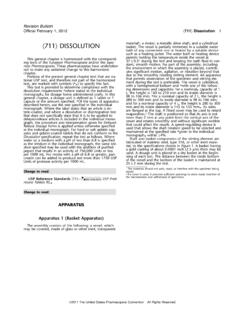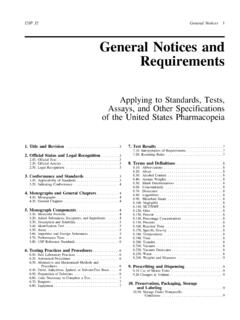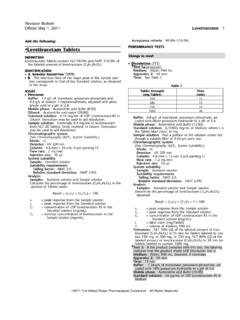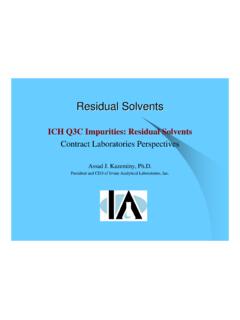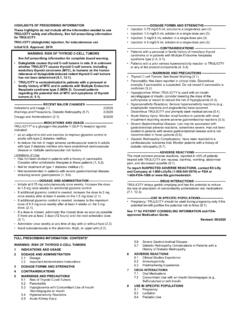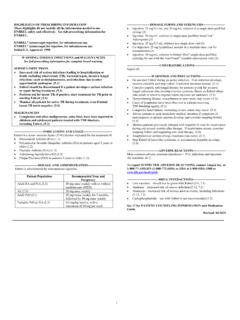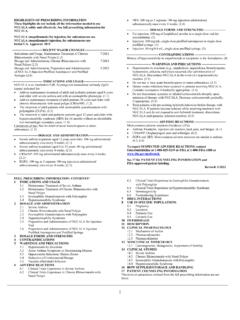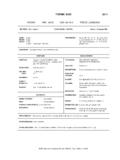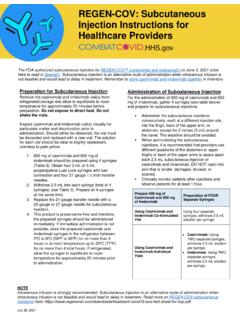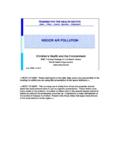Transcription of PARTICULATE MATTER IN INJECTIONS TEST - USP-NF
1 Revision BulletinOfficial July 1, 2012 788 PARTICULATE MATTER in Injections1 788 PARTICULATE MATTER ININJECTIONSC hange to read:This general chapter is harmonized with the correspond-ing texts of the European Pharmacopoeia and/or the Japa-nese Pharmacopoeia. These pharmacopeias have undertakennot to make any unilateral change to this harmonizedchapter. Portions of the present general chapter text thatare national USP text, and therefore not part of the harmo-nized text, are marked with symbols (FF) to specify MATTER in INJECTIONS and parenteral infusionsconsists of extraneous mobile undissolved particles, otherthan gas bubbles, unintentionally present in the stated in INJECTIONS 1 , solutions for injection adminis-tered by the intramuscular or subcutaneous route mustmeet the requirements of PARTICULATE MATTER in INJECTIONS 788 . This requirement has been indefinitely postponedfor products for veterinary use.
2 (RB 1-Oct-2011) Parenteralspackaged and labeled exclusively for use as irrigating solu-tions are exempt from the requirements of PARTICULATE Mat-ter in INJECTIONS 788 . Radiopharmaceutical preparations areexempt from the requirements of PARTICULATE MATTER in Injec-tions 788 . Parenteral products for which the labeling spec-ifies use of a final filter prior to administration are exemptfrom the requirements of PARTICULATE MATTER in INJECTIONS 788 , provided that scientific data are available to justifythis the determination of PARTICULATE MATTER , two proce-dures, Method 1 (Light Obscuration Particle Count Test) andMethod 2 (Microscopic Particle Count Test), are specifiedhereinafter. When examining INJECTIONS and parenteral infu-sions for subvisible particles, Method 1 is preferably , it may be necessary to test some preparations bythe Light Obscuration Particle Count Test followed by theMicroscopic Particle Count Test to reach a conclusion on con-formance to the all parenteral preparations can be examined for sub-visible particles by one or both of these methods.
3 WhenMethod 1 is not applicable, , in the case of preparationshaving reduced clarity or increased viscosity, the testshould be carried out according to Method 2. Emulsions,colloids, and liposomal preparations are examples. Similarly,products that produce air or gas bubbles when drawn intothe sensor may also require microscopic particle count test-ing. If the viscosity of the preparation to be tested is suffi-ciently high so as to preclude its examination by either testmethod, a quantitative dilution with an appropriate diluentmay be made to decrease viscosity, as necessary, to allowthe analysis to be results obtained in examining a discrete unit orgroup of units for PARTICULATE MATTER cannot be extrapo-lated with certainty to other units that remain , statistically sound sampling plans must be developedif valid inferences are to be drawn from observed data tocharacterize the level of PARTICULATE MATTER in a large groupof units.
4 FFor the purpose of this chapter, small-volume paren-teral is synonymous with small-volume injection , and large-volume parenteral is synonymous with large-volume (RB 1-Jul-2012)METHOD 1 LIGHT OBSCURATION PARTICLE COUNTTESTUse a suitable apparatus based on the principle of lightblockage that allows for an automatic determination of thesize of particles and the number of particles according tosize. The definition for particle-free water is provided in Re-agents, Indicators, and Solutions Reagent apparatus is calibrated using dispersions of sphericalparticles of known sizes between 10 mm and 25 mm. Thesestandard particles are dispersed in particle-free water. Caremust be taken to avoid aggregation of particles during dis-persion. FSystem suitability can be verified by using theUSP Particle Count PrecautionsThe test is carried out under conditions limiting particu-late MATTER , preferably in a laminar flow carefully wash the glassware and filtration equip-ment used, except for the membrane filters, with a warmdetergent solution, and rinse with abundant amounts ofwater to remove all traces of detergent.
5 Immediately beforeuse, rinse the equipment from top to bottom, outside andthen inside, with particle-free care not to introduce air bubbles into the prepara-tion to be examined, especially when fractions of the prep-aration are being transferred to the container in which thedetermination is to be carried order to check that the environment is suitable for thetest, that the glassware is properly cleaned, and that thewater to be used is particle-free, the following test is carriedout. Determine the PARTICULATE MATTER in five samples ofparticle-free water, each of 5 mL, according to the methoddescribed below. If the number of particles of 10 mm orgreater size exceeds 25 for the combined 25 mL, the pre-cautions taken for the test are not sufficient. The prepara-tory steps must be repeated until the environment, glass-ware, and water are suitable for the the contents of the sample by slowly inverting thecontainer 20 times successively.
6 If necessary, cautiously re-move the sealing closure. Clean the outer surfaces of thecontainer opening using a jet of particle-free water, and re-move the closure, avoiding any contamination of the con-tents. Eliminate gas bubbles by appropriate measures suchas allowing to stand for 2 min or large-volume parenterals, single units are tested. Forsmall-volume parenterals less than 25 mL in volume, thecontents of 10 or more units are combined in a cleanedcontainer to obtain a volume of NLT 25 mL; the test solu-tion may be prepared by mixing the contents of a suitablenumber of vials and diluting to 25 mL with particle-freewater or with an appropriate particle-free solvent when par-ticle-free water is not suitable. Small-volume parenterals hav-ing a volume of 25 mL or more may be tested for parenteral use are reconstituted with particle-free water or with an appropriate particle-free solvent whenparticle-free water is not number of test specimens must be adequate to pro-vide a statistically sound assessment.
7 For large-volumeparenterals or for small-volume parenterals having a volumeof 25 mL or more, fewer than 10 units may be tested,using an appropriate sampling four portions, NLT 5 mL each, and count thenumber of particles equal to or greater than 10 mm and 2012 The United States Pharmacopeial ConventionAll Rights Bulletin2 788 PARTICULATE MATTER in InjectionsOfficial July 1, 201225 mm. Disregard the result obtained for the first portion,and calculate the mean number of particles for the prepa-ration to be preparations supplied in containers with a nominalvolume of more than 100 mL, apply the criteria of Test preparations supplied in containers with a nominalvolume of less than 100 mL, apply the criteria of Test preparations supplied in containers with a nominalvolume of 100 mL, apply the criteria of Test [NOTE Test is used in the Japanese Pharmacopoeia.]If the average number of particles exceeds the limits, testthe preparation by the Microscopic Particle Count (Solutions for parenteral infusion or solutions forinjection supplied in containers with a nominal content ofmore than 100 mL) The preparation complies with the testif the average number of particles present in the unitstested does not exceed 25 per mL equal to or greater than10 mm and does not exceed 3 per mL equal to or greaterthan 25 (Solutions for parenteral infusion or solutions forinjection supplied in containers with a nominal content of lessthan 100 mL)
8 The preparation complies with the test ifthe average number of particles present in the units testeddoes not exceed 6000 per container equal to or greaterthan 10 mm and does not exceed 600 per container equalto or greater than 25 2 MICROSCOPIC PARTICLE COUNT TESTUse a suitable binocular microscope, a filter assembly forretaining PARTICULATE MATTER , and a membrane filter microscope is adjusted to 100 10 magnificationsand is equipped with an ocular micrometer calibrated withan objective micrometer, a mechanical stage capable ofholding and traversing the entire filtration area of themembrane filter, and two suitable illuminators to provideepiscopic illumination in addition to oblique ocular micrometer is a circular diameter graticule(see Figure 1) and consists of a large circle divided bycrosshairs into quadrants, transparent and black referencecircles 10 mm and 25 mm in diameter at 100 magnifica-tions, and a linear scale graduated in 10-mm increments.
9 Itis calibrated using a stage micrometer that is certified byeither a domestic or international standard institution. A rel-ative error of the linear scale of the graticule within 2% isacceptable. The large circle is designated the graticule fieldof view (GFOV).Figure 1. Circular diameter graticule. The large circle di-vided by crosshairs into quadrants is designated thegraticule field of view (GFOV). Transparent and black circleshaving 10-mm and 25-mm diameters at 100 are providedas comparison scales for particle illuminators are required. One is an episcopicbrightfield illuminator internal to the microscope, the otheris an external, focusable auxiliary illuminator that can beadjusted to give reflected oblique illumination at an angleof 10 20 .The filter assembly for retaining PARTICULATE MATTER con-sists of a filter holder made of glass or other suitable mate-rial, and is equipped with a vacuum source and a suitablemembrane membrane filter is of suitable size, black or dark grayin color, nongridded or gridded, and mm or finer innominal pore PrecautionsThe test is carried out under conditions limiting particu-late MATTER , preferably in a laminar flow carefully wash the glassware and filter assemblyused, except for the membrane filter, with a warm deter-gent solution, and rinse with abundant amounts of waterto remove all traces of detergent.
10 Immediately before use,rinse both sides of the membrane filter and the equipmentfrom top to bottom, outside and then inside, with particle-free order to check that the environment is suitable for thetest, that the glassware and the membrane filter are prop-erly cleaned, and that the water to be used is particle-free,the following test is carried out. Determine the particulatematter of a 50-mL volume of particle-free water accordingto the method described below. If more than 20 particles10 mm or larger in size or if more than five particles 25 mmor larger in size are present within the filtration area, theprecautions taken for the test are not sufficient. The prepar-atory steps must be repeated until the environment, glass-ware, membrane filter, and water are suitable for the the contents of the samples by slowly inverting thecontainer 20 times successively. If necessary, cautiously re-move the sealing closure.
